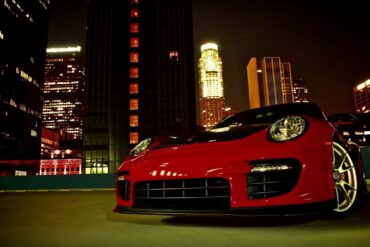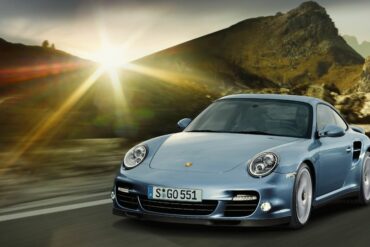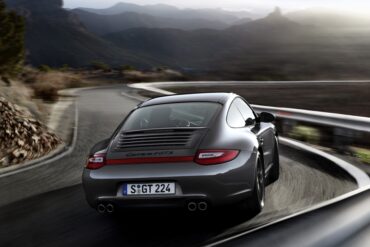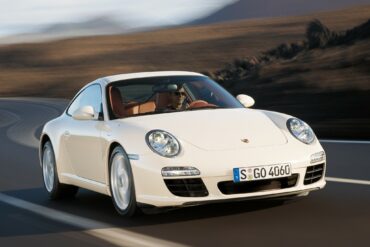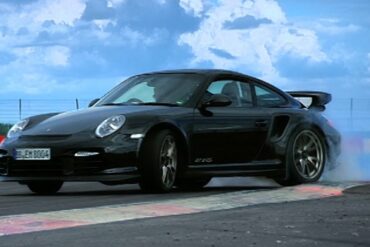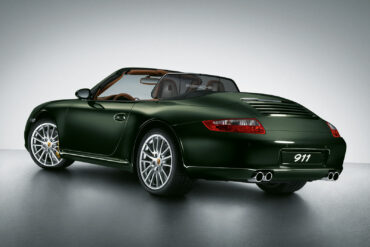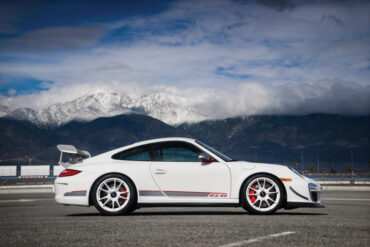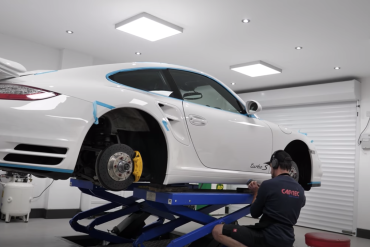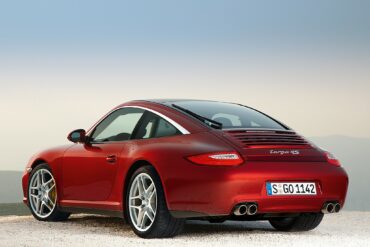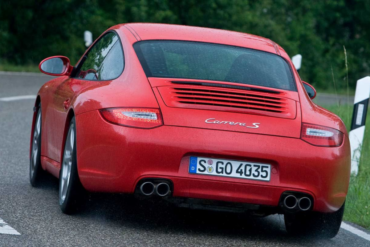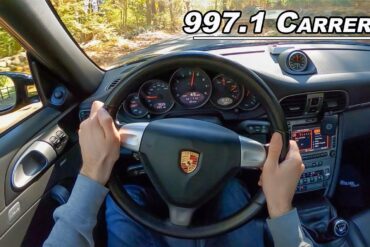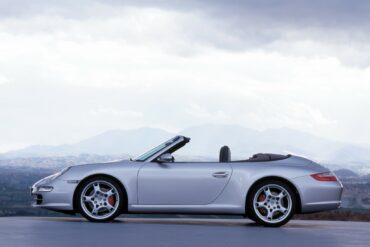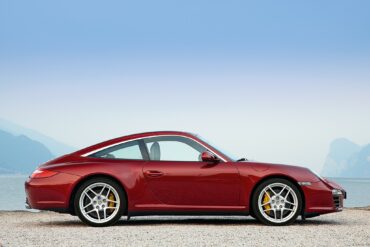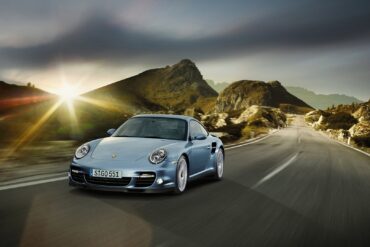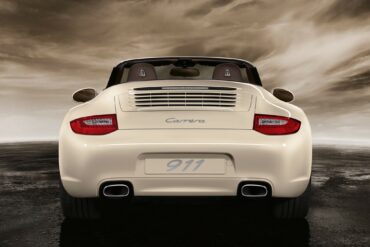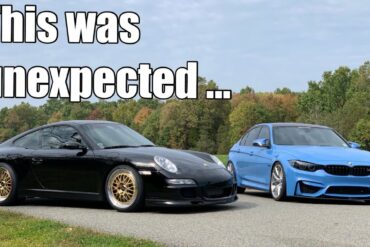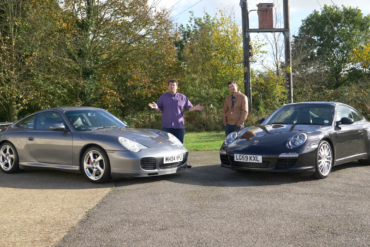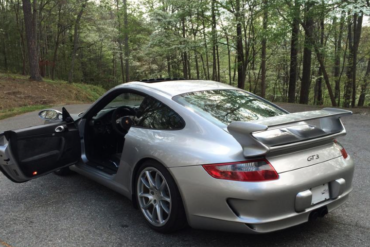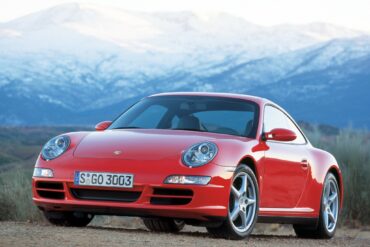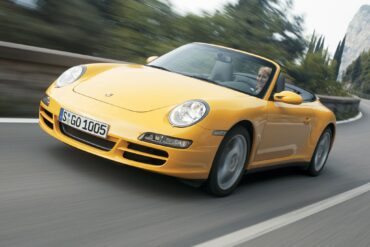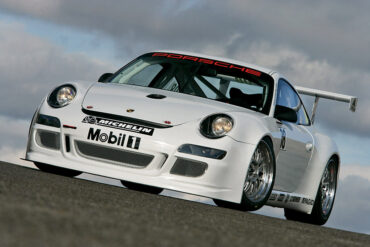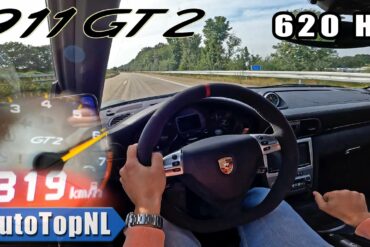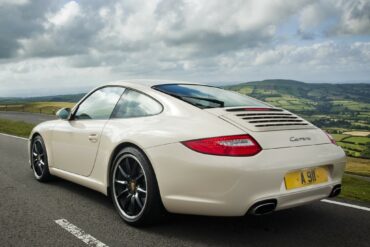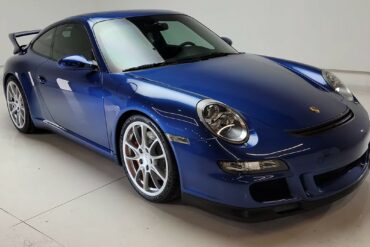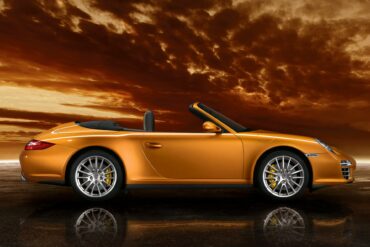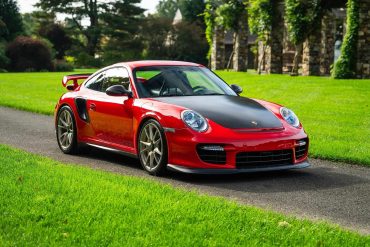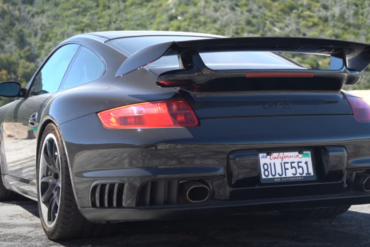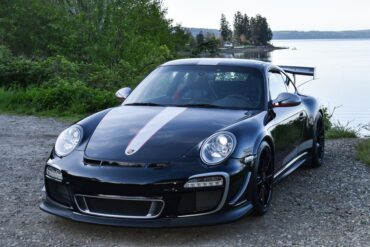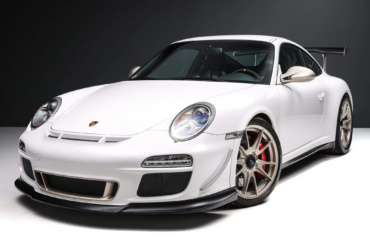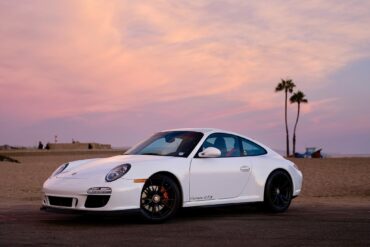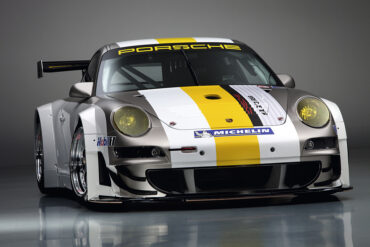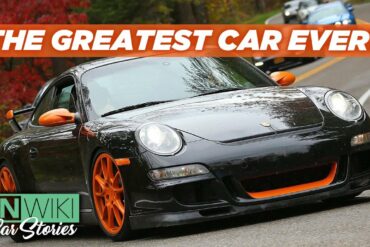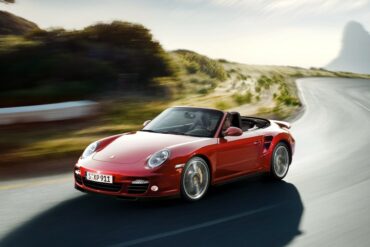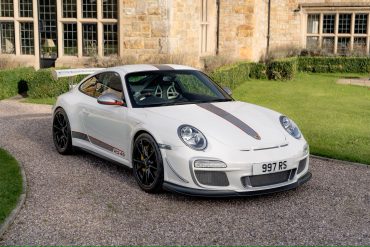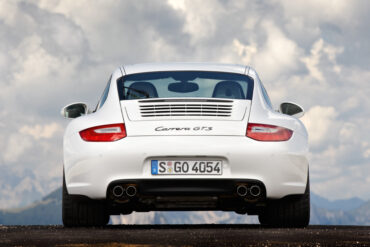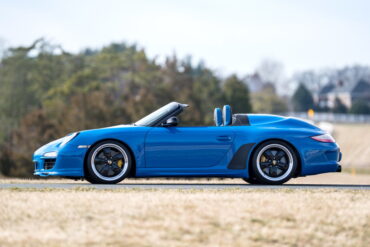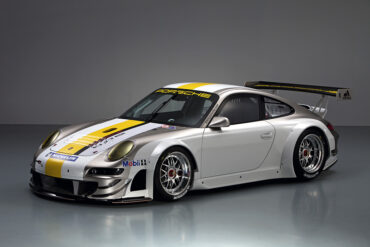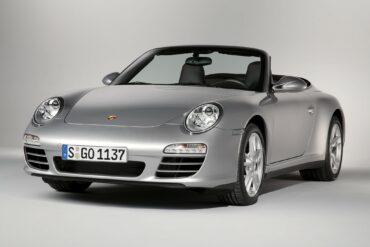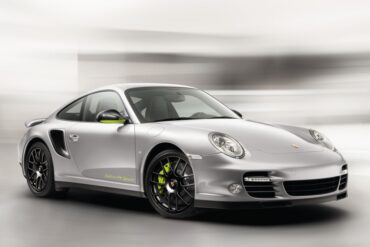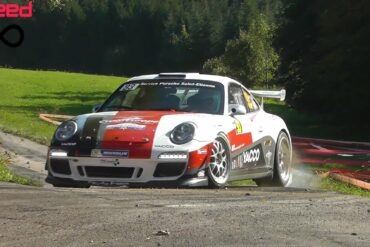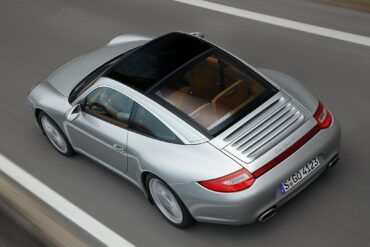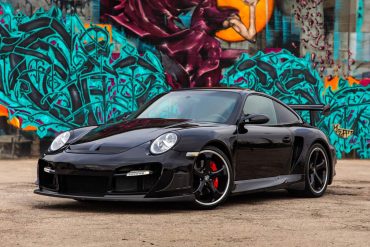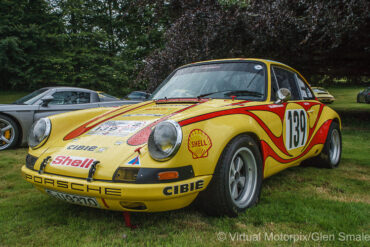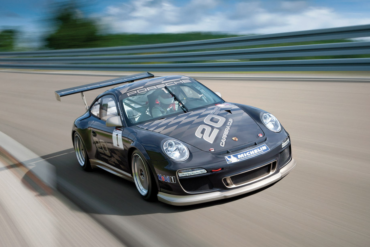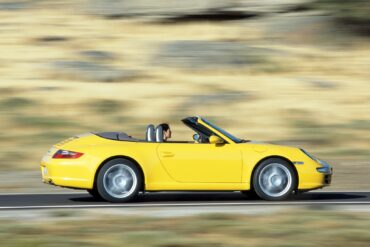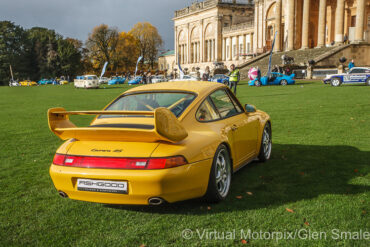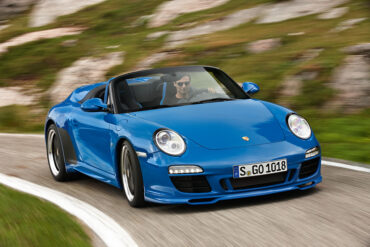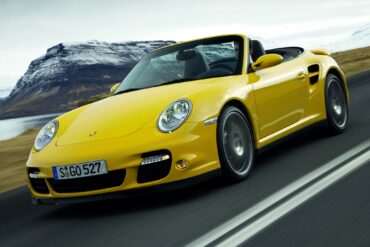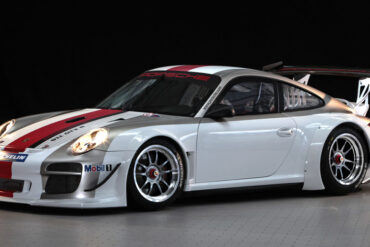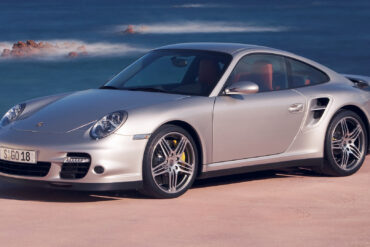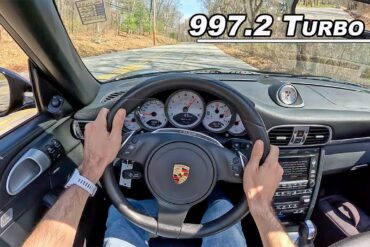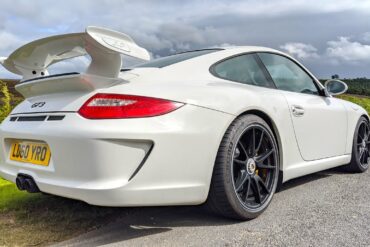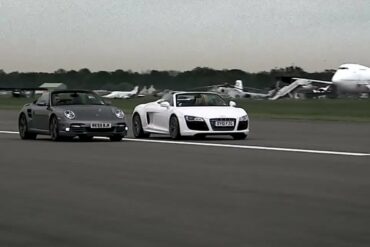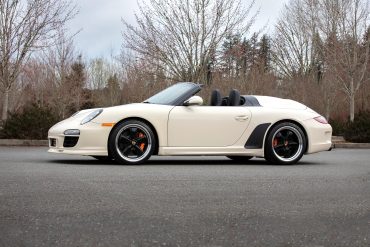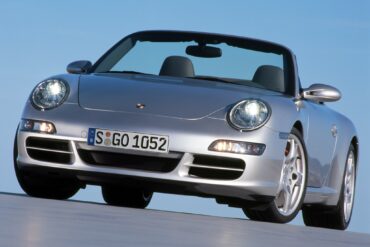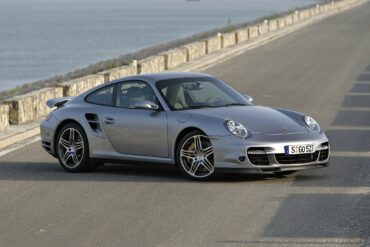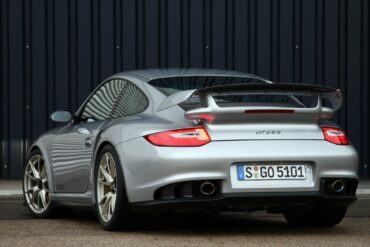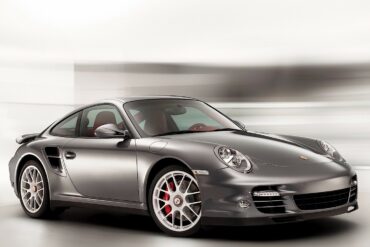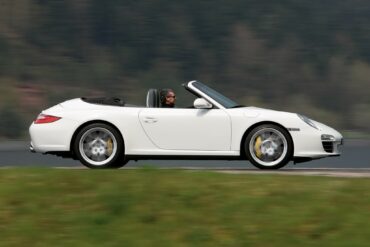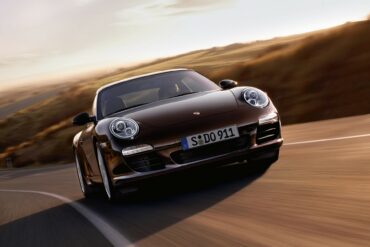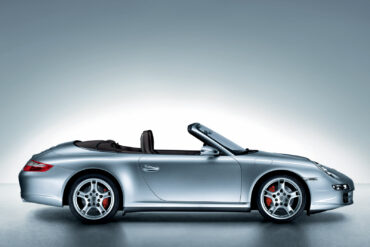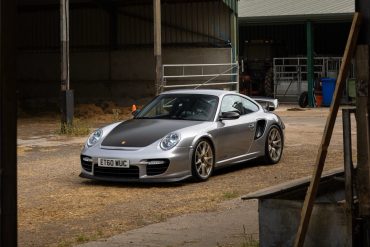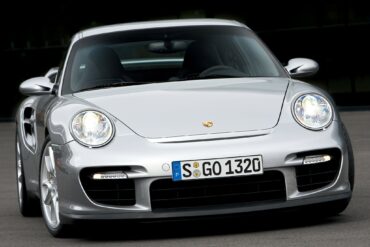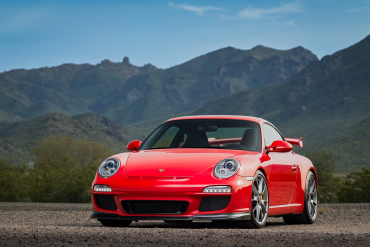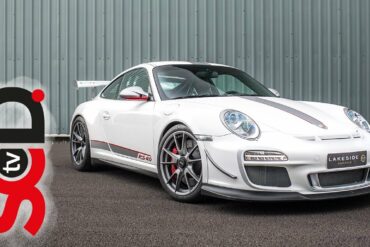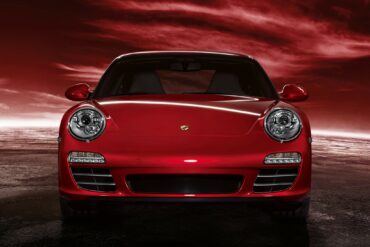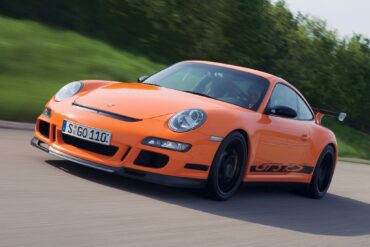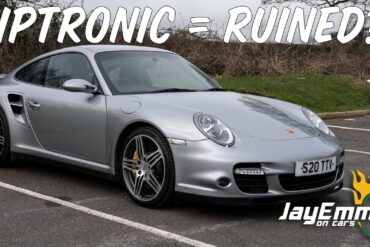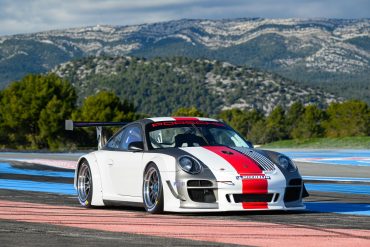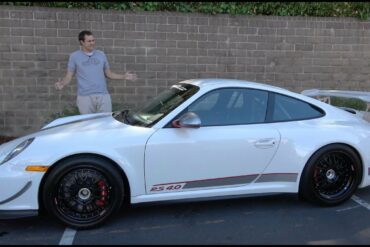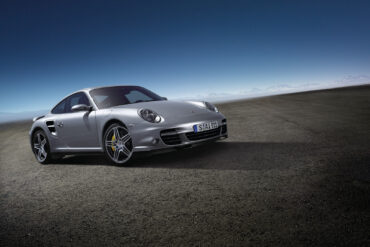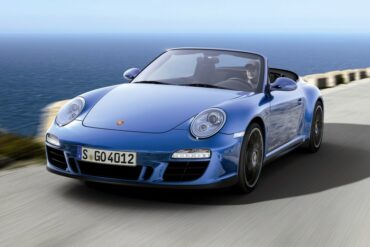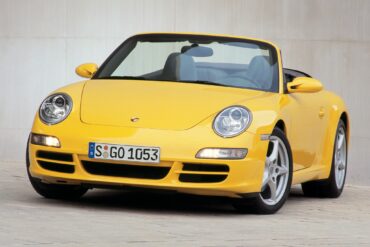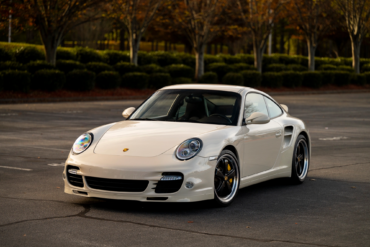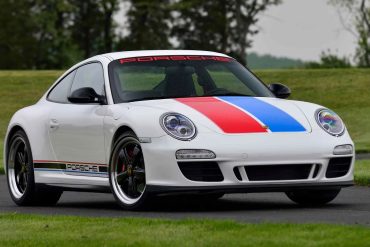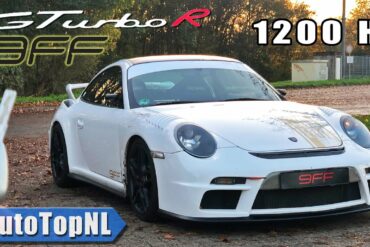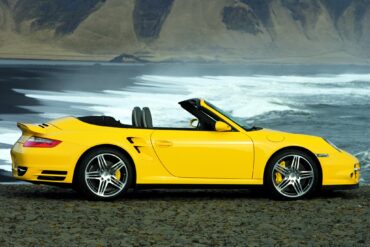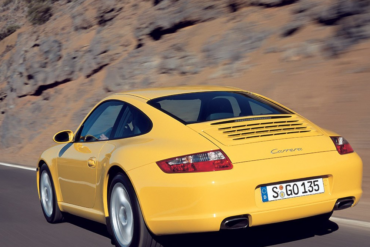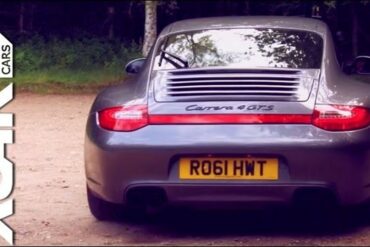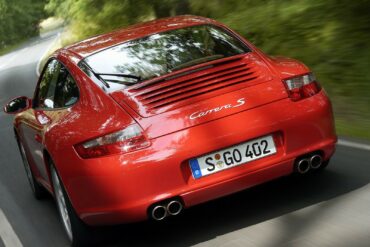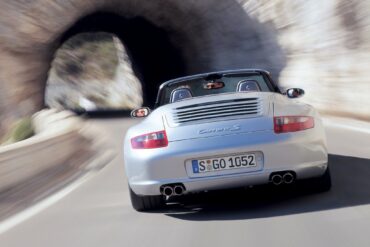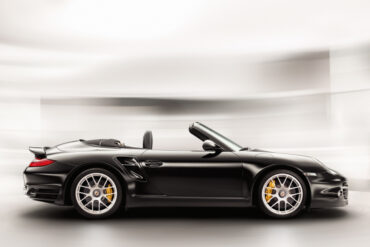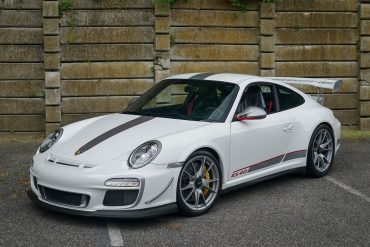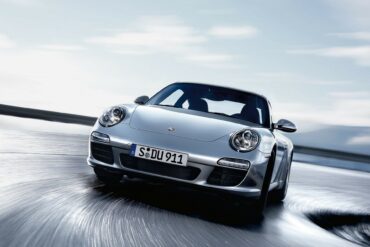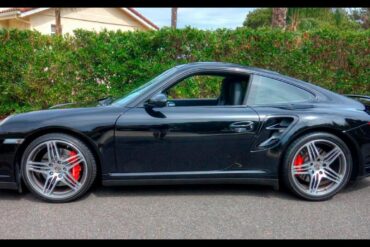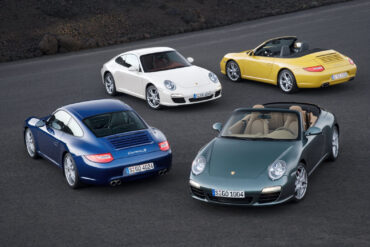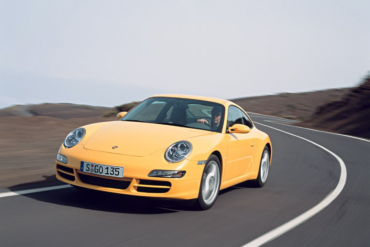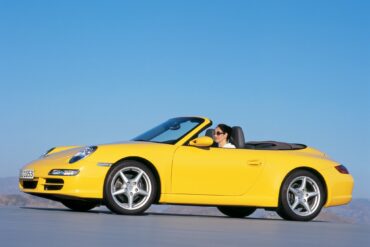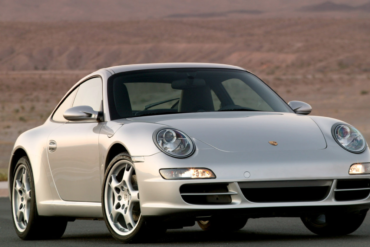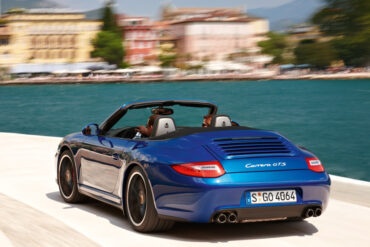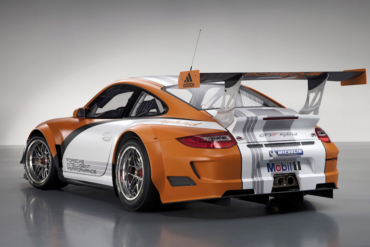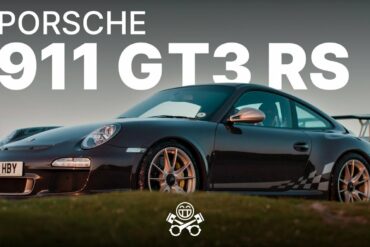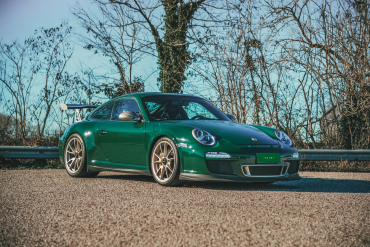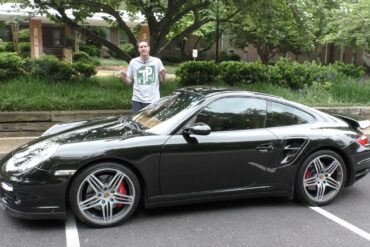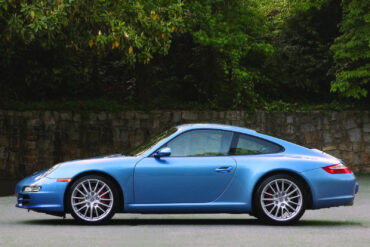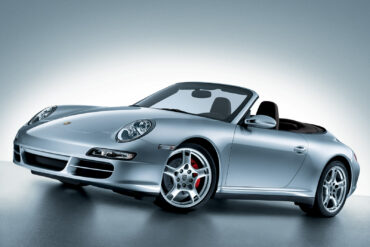Porsche 911 GT2 RS Top Gear Review The team takes the Porsche 911 GT2 RS around the closed streets of...
Porsche Option Codes – Porsche 911 (2011 Model Year) Looking to decode your 2011 Porsche 911 option codes? Want to...
2012 Porsche 911 Carrera 4 GTS Coupe (997) Technical Specifications Engine Type Flat 6 Induction Normally-aspirated Cooling Water-cooled Valvetrain Double overhead...
Porsche refers to it as a new generation, even though the internal chassis code 997 remains unchanged. The 997.2 therefore is more of a mid-term facelift with some significant technological changes. Notably, the water-cooled flat-six engines get direct-injection technology, and a seven-speed, dual-clutch transmission replaces the previous five-speed Tiptronic automatic while the shift-it-yourself option remains a six-speed. Base Carrera coupe gets 339 bhp and 287 ft lbs and a 0.3 second faster 0 - 60 mph time of 4.5 seconds. Top speed now 179 mph. A nice update indeed.
Thrashing Porsche’s Most Epic Car It’s #ThrowbackThursday! Jason is trying out the Porsche 911 GT2 RS to see if it...
2008 Porsche 911 Carrera Cabriolet (997) Technical Specifications Engine Type Flat 6 Induction Normally-aspirated Cooling Water-cooled Valvetrain Double overhead camshafts...
2011 Porsche 911 GT3 RS 4.0 (997) Technical Specifications Engine Type Flat 6 Induction Normally-aspirated Cooling Water-cooled Valvetrain Double overhead camshafts...
Detailing a 997.2 Turbo S – Paint Correction, Wheels Off + Modesta Coatings We all know how obsessed we are...
2020 Porsche 911 Carrera S vs 2010 Porsche 911 Carrera S This is the new 2020 911 Carrera S, and...
2009 Porsche 911 Targa 4S (997.2) Technical Specifications Engine Type Flat 6 Induction Normally-aspirated Cooling Water-cooled Valvetrain Double overhead camshafts Injection Direct...
2008 Porsche 911 (997.1) Carrera, Carrera S, Carrera 4, Carrera 4S, Turbo Service Schedule This maintenance service schedule checklist is ONLY...
The Base 997 Carrera is Better Than You Thought The Base 997.1 Carrera is often overlooked because it is the...
2005 Porsche 911 Carrera S Cabriolet (997) Technical Specifications Engine Type Flat 6 Induction Normally-aspirated Cooling Water-cooled Valvetrain Double overhead...
2010 Porsche 911 Targa 4S (997.2) Technical Specifications Engine Type Flat 6 Induction Normally-aspirated Cooling Water-cooled Valvetrain Double overhead camshafts Injection Direct...
Porsche 911 (997) Technical Specs & Performance Porsche 911 (997) Production Car Specs Looking at the tables above, the conclusion...
2011 Porsche 911 Carrera Cabriolet (997.2) Technical Specifications Engine Type Flat 6 Induction Normally-aspirated Cooling Water-cooled Valvetrain Double overhead camshafts...
This is why every car enthusiast should consider a 997 Porsche Carrera S ...
Which Is a Better First Porsche? 996 C4S vs 997.2 C2 If you’re looking to buy your first 911, and...
2006 – 2009 Porsche 911 GT3 & GT3 RS (997.1) Service Schedule This maintenance service schedule checklist is ONLY for...
The 997 Carrera 4 was the all-wheel-drive version of the standard 997 Carrera and it arrived as a 2006 model year car (along with the 4S models). The 997.1 Carrera 4 had a3.6 L Watercooled Flat 6 (M96/05) engine that was good for 321 bhp @ 6800 rpm and 273 ft lbs @ 4250 rpm. It had a sub 5 second 0 - 60 mph hour time and a top speed of 174 mph. The transmission (six-speed manual or five-speed Tiptronic) feeds a forward propshaft that mates to a viscous coupling unit with a front differential.
The Carrera 4 Cabriolet was released with the rest of the 4 and 4S models as 2006 model year cars. With a sure-footed, four-wheel drive powertrain as well as that "wide-body" stance, and with tops that open or close at the touch of a button, the Carrera 4 Cabriolet really started to make the case it could do it all. The wide look gave the 4 a widened track, larger wheels and tires and four-wheel-drive powertrain that gives more dynamic stability, especially in inclement weather conditions. Developed at the same time as the coupe.
To a large extent, the 3.6-litre boxer engine is identical to the power unit used in the Porsche Mobil1 Supercup and the international Carrera Cup championships. Power output has increased by 20 horsepower to now 440 hp (324 kW) at 8,000 rpm. Maximum torque is up by ten Nm to 430 at 7,250 revs per minute. The power increase results from optimised engine electronics and a modified exhaust system. In contrast to the GT3 Cup, the body of the Cup S is not based on the road-going GT3 but on the GT3 RS.
2011 Porsche 911 Carrera (997.2) Technical Specifications Engine Type Flat 6 Induction Normally-aspirated Cooling Water-cooled Valvetrain Double overhead camshafts Injection Direct...
Watch this Cobalt Blue Porsche 997 GT3 get the love and care it deserves as it is given some interior...
2010 Porsche 911 Carrera 4 Cabriolet (997.2) Technical Specifications Engine Type Flat 6 Induction Normally-aspirated Cooling Water-cooled Valvetrain Double overhead camshafts Injection...
Porsche introduced the 997 GT2 RS in the United States in October 2010 with an initial price of $245,000 MSRP....
Is The 997 GT2 Really a $170k Experience? Based on the 997 Turbo, the GT2 was by the far the...
2009 – 2012 Porsche 911 GT3 & GT3 RS (997.2) Service Schedule (3.8 L & 4.0 L) This maintenance service...
This particular 2011 Porsche 911 GT3 RS is one of only 541 built for the US market during a two-year...
With a power output of 408 hp, outstanding vehicle dynamics and emphatically sporty equipment, the 997.2 Carrera GTS ascends to...
Porsche has announced the introduction of the new 2007 911 GT3 RSR (type 997) for the American Le Mans Series and other world GT racing venues. The latest version of the most successful racing sports car in history is based on the street production model 911 GT3 RS (model year 2007) and was launched in late 2006. The 911 GT3 RSR has wider rear fenders and rear track to improve performance capabilities over its predecessor. The car has also been developed to fit into the 1,225 kg class. The new car is built in accordance with the ACO LMGT2 Regulations and the FIA Article 257.
The Porsche 997.1 GT3 is the greatest car ever! Rob Ferretti explains why he thinks the Porsche 997.1 GT3 is...
2010 Porsche 911 Turbo Cabriolet (997.2) Technical Specifications Engine Type Flat 6 Induction Twin-turbocharged Cooling Water-cooled Valvetrain Double overhead camshafts Injection Direct...
Built to homologate the 2011 GT3 RSR racecar, the RS 4.0 is fitted with the 3996cc engine which raises power output...
2012 Porsche 911 Carrera GTS Coupe (997) Technical Specifications Engine Type Flat 6 Induction Normally-aspirated Cooling Water-cooled Valvetrain Double overhead camshafts...
2011 Porsche 911 Speedster (997) Technical Specifications Engine Type Flat 6 Induction Normally-aspirated Cooling Water-cooled Valvetrain Double overhead camshafts Injection Direct...
2011 Porsche 911 GT3 RSR (997) Technical Specifications Engine B6 w/Dry Sump Lubrication, 29.5 mm Air Restrictors Position Rear, Longitudinal...
The 2009 Porsche 911 Carrera 4 Cabriolet shares the same internal 997 model designation as its Coupe siblings. It also shares the same essential all-wheel-drive architecture, interior appointments, suspensions and drivetrains. It is an open-top sports cars that deliver the same exhilarating acceleration and dynamic response as the coupes, regardless of weather or road conditions. The Carrera 4 Cabriolet boast a unique body over their all-wheel-drive powertrains with a wide-body design.
Based on the 530-bhp 911 Turbo S, the special-edition Porsche has carbon-fiber trim inside and out, plus upgraded leather, badging and the exterior colors of the 918, including the use of Acid Green on the brake calipers, illuminated sill plates, interior stitching and instrument cluster needles. Also limited to 918 units, the 911 Turbo S Edition 918 Spyder will be available in Coupe ($160,700) and Cabriolet ($172,100) forms, making this one very expensive dealer option.
Porsche 997 GT3 Rally Cars Sounding Spectacular...
2012 Porsche 911 Targa 4 (997.2) Technical Specifications Engine Type Flat 6 Induction Normally-aspirated Cooling Water-cooled Valvetrain Double overhead camshafts Injection...
In 2011, Porsche China released a special limited edition model to celebrate an active decade in the Chinese market. The Porsche 10 Year Anniversary Edition is yet another 911 of only ten copies, each with a stylish plaque with the chassis number. The Porsche has a Gold Bronze Metallic paint, combined with matte black carbon components such as the hood, rear wing, tailgate and side mirrors. Underneath, you will spot a 911 Turbo S. The interior is a combination of black with gold stitching leather, alcantara and carbon.
This 2007 Porsche 911 Turbo has been modified with TechArt’s GTstreet R package, featuring an aerodynamic carbon fiber bodykit, 20″...
Rennsport Collective, Donington Hall, 20 July 2019: Porsche 996 GT1 Evo 1997 on display with numerous other Porsche classics They...
2010 Porsche 911 GT3 Cup (997) Technical Specifications Engine Location : Rear Drive Type : Rear Wheel Body / Chassis : Unitary...
2005 Porsche 911 Carrera Cabriolet (997) Technical Specifications Engine Type Flat 6 Induction Normally-aspirated Cooling Water-cooled Valvetrain Double overhead camshafts...
Paying homage to the first Porsche model that bore the name Speedster – the 356 Speedster – the production run for the new model is limited to 356 cars. The two-seater is significantly different from the other members of the 911 family. In the best tradition, the 60 millimetre lower, more raked windscreen, the flat contour of the sporty-look manual hood, and the characteristic double-bubble hardcover for the soft top define the striking profile of the new 911 Speedster. This makes the body of this rear-wheel drive with its 44 millimetre wider rear stand out even more.
Like the 911 Turbo Coupe, the 997 Turbo Cabriolet is powered by a 3.6 liter six-cylinder boxer engine with biturbo turbocharging and Variable Turbine Geometry (VTG). The powerplant already generates 480 hp (473 bhp) and 460 ft lbs of torque at 1950 rpm. The manual transmission version can accelerate from 0 to 100 km/h in just four seconds while the Tiptronic S the time can be cut to 3.6 seconds. Top speed for the Cab is the same 193 mph as Coupe and only weighs 70 kilos.
The Sound of Hillclimb Happiness Rampa da Falperra specialist José Silvino Pires took his beautiful Porsche 997 GT3-R once again...
Following the Porsche 911 GT3 Cup, Porsche AG, Stuttgart, is entering yet another racing car in the 2010 motorsport season: The 911 GT3 R will be raced in series based on the international FIA GT3 regulations, thus succeeding the 911 GT3 Cup S. The main focus in developing this new model was on even better drivability and even easier handling. The 911 GT3 R is powered by a four-litre six-cylinder boxer engine delivering maximum output of 480 bhp (353 kW) transmitted to the rear axle by a sequential six-speed dog gearbox.
2005-2007 Porsche 911 (997.1) Carrera, Carrera S, Carrera 4, Carrera 4S, Turbo Service Schedule This maintenance service schedule checklist is...
The convertible version of a performance car is often debated as unnecessary by some people, citing the reduction in structural...
Porsche 997 GT3 Review Thanks to my good buddy Tom, I got behind the wheel of his incredible Porsche 911...
Top Gear Drag Race – Audi R8 vs Porsche 997 Jeremy heads out on to the test track and pits the...
The 2011 Porsche 911 Speedster is a unique blend of classic features from the original Speedster model, the 356 Speedster,...
The Carrera S convertible was introduced to the market at the same time with the Carrera Cabriolet, a few months after their coupe-versions were unveiled. The convertible version for the Carrera S got reinforcements needed for the cabriolet built while the engineering was going on for the coupe, ensuring that the drop-top version was just as strong and performance-focused. It got the same engine as the Carrera S and made a case for itself as the best 911 of the range at the time.
2007 Porsche 911 Turbo (997) Technical Specifications Engine Type Flat 6 Induction Twin-turbocharged Cooling Water-cooled Valvetrain Double overhead camshafts Injection Port...
2011 Porsche 911 GT2 RS (997) Technical Specifications Engine Type Flat 6 Induction Twin-turbocharged Cooling Water-cooled Valvetrain Double overhead camshafts Injection Port...
The 997.2 Turbo was introduced for the 2010 model year and received a new 3.8 litre engine capable of 493 horsepower, a significant evolution as compared to the 473hp in the 997.1 Turbo. The 997.2 Turbo was available in both manual and automatic transmissions, but the automatic evolved from the Tiptronic used in its predecessor, to a sportier dual-clutch PDK. Approximately 3,300 coupes were produced and 1,800 cabrios, far less than its predecessor. An epic all-around GT with more performance than you could ever need.
2012 Porsche 911 Carrera 4S Cabriolet (997.2) Technical Specifications Engine Type Flat 6 Induction Normally-aspirated Cooling Water-cooled Valvetrain Double overhead camshafts Injection...
2012 Porsche 911 Carrera S Coupe (997.2) Technical Specifications Engine Type Flat 6 Induction Normally-aspirated Cooling Water-cooled Valvetrain Double overhead camshafts...
2008 Porsche 911 Carrera 4S Coupe (997) Technical Specifications Engine Type Flat 6 Induction Normally-aspirated Cooling Water-cooled Valvetrain Double overhead...
The 2011 Porsche 911 GT2 RS is a brute, a lightweight, twin-turbocharged, 620-hp bout of madness that stemmed from Stuttgart’s...
2009 Porsche 911 GT2 (997) Technical Specifications Engine Type Flat 6 Induction Twin-turbocharged Cooling Water-cooled Valvetrain Double overhead camshafts Injection Port...
Experience the thrill of driving with this stunning 2010 Porsche 911 GT3, powered by a 3.8-liter flat-six engine with a...
GT3 RS 4.0 RS Ride & Review Our first video with Henry at Lakeside Classics and what a way to...
2011 Porsche 911 Carrera 4S Coupe (997.2) Technical Specifications Engine Type Flat 6 Induction Normally-aspirated Cooling Water-cooled Valvetrain Double overhead camshafts Injection...
The 997 911 GT3 RS is an even lighter and more purist version of the 911 than the regular GT3. 20 kilograms lighter than the GT3 and equipped with a close-ratio six speed manual the GT3 RS gets to 60 mph 1/10th of a second faster than the GT3. The 911 GT3 RS is 44mm wider at the rear than the GT3. The wider track helps improve directional stability when cornering. Weight savings can be found throughout the car. The Clubsport version there is a bolted roll cage, a six-point harness for the driver and a built in fire extinguisher.
Porsche 911 997 Turbo PDK Review Today I’m driving Scott’s 911 997 Turbo. This car is equipped with the tiptonic...
The race-ready 911 GT3 R, developed by German sports car manufacturer Porsche in accordance with FIA GT3 regulations, made its...
Doug DeMuro Reviews the 911 GT3RS 4.0 The 2011 Porsche 911 GT3RS 4.0 is one of the most desirable modern...
Porsche 911 (997) Sales & Production Numbers In total, the Porsche 997 sold 212,964 units over its production life. It...
The Cabriolet version of the new Porsche 911 Carrera 4 GTS is just as potent as its coupe sibling. It combines a 408 hp 3.8-litre flat six engine with intelligent all-wheel drive that delivers a further exhilarating dimension to the dynamics of the iconic rear-engined sports car. The 911 was first offered with four-wheel drive in 1989 and the drivetrain has been a popular option ever since. Now, the 911 Carrera 4 GTS broadens customer choice in 2011, building on the success of the two-wheel drive Carrera GTS that went on sale in December last year. Carrera 4 GTS power unit is the 3.8-litre flat six with power kit.
Just a few months after the introduction of the 2004 911 (997 series), the convertible version was released. The release of the 997 911 Carrera Cabriolet marked the first time since 1977 that Porsche has given the convertible 911s the same engines as their Coupe siblings. The base 997 Carrera Cabriolet gets the 3.6-liter flat six-cylinder engine with 321 bhp and 273 ft lbs of torque. The convertible version for both Carrera and Carrera S was developed at the same time with the coupe.
Bring A Trailer is currently offering a 2011 Porsche 911 Turbo S with just 6k miles since new. Aside from...
Porsche and Brumos Racing have once again delved into their shared history to craft an exceptional Porsche 911 Carrera GTS...
Top Speed On the Autobahn In A 9ff 911 GT3 1200HP Porsche 9ff 911 GT3 *HUGE TURBO* REVIEW on AUTOBAHN...
2009 Porsche 911 Turbo Cabriolet (997) Technical Specifications Engine Type Flat 6 Induction Twin-turbocharged Cooling Water-cooled Valvetrain Double overhead camshafts Injection...
2005 Porsche 911 Carrera (997) Technical Specifications Engine Type Flat 6 Induction Normally-aspirated Cooling Water-cooled Valvetrain Double overhead camshafts Injection...
Porsche 911 Carrera 4 GTS (997): A Greatest Hits Collection? The GTS variants of the 997 Porsche 911 were regarded...
2006 Porsche 911 Carrera S Coupe (997) Technical Specifications Engine Type Flat 6 Induction Normally-aspirated Cooling Water-cooled Valvetrain Double overhead...
2006 Porsche 911 Carrera S Cabriolet (997) Technical Specifications Engine Type Flat 6 Induction Normally-aspirated Cooling Water-cooled Valvetrain Double overhead...
Everybody knows we are huge fans of the Porsche 997, but if you were shopping for one today, which one...
2011 Porsche 911 Turbo S Cabriolet (997) Technical Specifications Engine Type Flat 6 Induction Twin-turbocharged Cooling Water-cooled Valvetrain Double overhead camshafts...
The guys at PCarMarket have an auction going at the moment that all Porsche fans should know about. A final salute...
2012 Porsche 911 Carrera (997.2) Technical Specifications Engine Type Flat 6 Induction Normally-aspirated Cooling Water-cooled Valvetrain Double overhead camshafts Injection Direct...
High Speed Run In a 997.1 Turbo The Porsche 997 Turbo can now be had for just under half it’s...
Sorry, but you do not have permission to view this content....
The base Carrera has essentially the same 3.6 L flat-6 engine that its predecessor, the Type 996 Carrera used, now good for 321 bhp @ 6800 rpm and with torque of 273 ft lbs @ 4250 rpm. The sprint from 0 to 60 mph is over in just 4.80 seconds and top speed is 177 mph. The quarter mile is over in a respectable 13.1 seconds. The 911 Carrera is now faster, more stable, more precise and forgiving, an altogether superior-make that more efficient-sports car than the 996.
2007 Porsche 911 Carrera Cabriolet (997) Technical Specifications Engine Type Flat 6 Induction Normally-aspirated Cooling Water-cooled Valvetrain Double overhead camshafts...
Porsche Option Codes – Porsche 911 (2005 Model Year) Looking to decode your 2005 Porsche 911 option codes? Want to...
2012 Porsche 911 Carrera GTS Cabriolet (997) Technical Specifications Engine Type Flat 6 Induction Normally-aspirated Cooling Water-cooled Valvetrain Double overhead camshafts...
2011 Porsche 911 GT3 R Hybrid 2.0 (997) Technical Specifications Engine Configuration B6 Location Rear, longitudinally mounted Construction aluminium block...
Porsche 911 GT3 RS (997.2) Drive Through the Hills As the Porsche 911 GT3 dynasty turns 20 years old this...
Based on the already primal 997.2 GT3, the RS gets another 15 hp from the 3.8-liter flat-six for a total...
Porsche 911 997 Turbo Video Review I think the “997” Porsche 911 Turbo is an amazing bargain, with some models...
2006 Porsche 911 Carrera S Club Coupe (997) Technical Specifications Engine Type Flat 6 Induction Normally-aspirated Cooling Water-cooled Valvetrain Double...
While the 997 Carrera 4S coupe sold a healthy 15,056 units between 2006 and 2008, the equally exciting Carrera 4S Cabriolet sold 12,587 units, making it a pretty popular 997 model. The reason is pretty simple. It had a gorgeous wide-body stance, all-wheel drive traction and that potent 3.8 L Flat 6 that was good for 350 bhp and 295 ft lbs of torque. The first convertible 911 that was as good a performer as it coupe siblings with the added benefit of open top driving in the summer with the comfort of being a great daily driver all year round.


